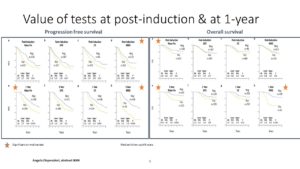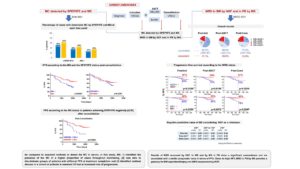Evaluation of response to therapy and the critical role of MRD and new approaches to imaging
Efstathios Kastritis, MD
National and Kapodistrian University of Athens
Several abstract confirmed the critical prognostic value of evaluation of MRD in newly diagnosed patients with myeloma treated with or without ASCT. Also, the potential of mass spectrometry for the detection of clonal immunoglobulins with high sensitivity in the serum was further strengthened as a tool for evaluation of MRD.
Two large, randomized maintenance studies explored ixazomib maintenance vs placebo in newly diagnosed patients after ASCT (MM3) or after completion of fixed duration primary therapy (MM4) in transplant ineligible patients. In this pooled analysis that was presented by B. Paiva in the EHA meeting (Abstract S184) from the two studies, MRDneg at randomization was associated with improved PFS (HR:0.465) as well as conversion from MRDpos to MRDneg during maintenance. Ixazomib maintenance was associated with improved PFS among MRDpos patients before maintenance (HR:0.651) and those who remained MRDpos during maintenance (HR:0.72) but not in patients that were MRDneg at randomization or throughout maintenance. Risk of progression or death was 8-fold higher among patients that failed to achieve or sustain MRDneg.
ASCT (MM3) or after completion of fixed duration primary therapy (MM4) in transplant ineligible patients. In this pooled analysis that was presented by B. Paiva in the EHA meeting (Abstract S184) from the two studies, MRDneg at randomization was associated with improved PFS (HR:0.465) as well as conversion from MRDpos to MRDneg during maintenance. Ixazomib maintenance was associated with improved PFS among MRDpos patients before maintenance (HR:0.651) and those who remained MRDpos during maintenance (HR:0.72) but not in patients that were MRDneg at randomization or throughout maintenance. Risk of progression or death was 8-fold higher among patients that failed to achieve or sustain MRDneg.
Prof. A. Dispenzieri presented in ASCO (abstract 8009) the results of the evaluation of mass spectrometry (Mass-Fix) against serum immunofixation (sIFE) for CR and vs MRD evaluation by next generation flow cytometry in patients that were enrolled in the STAMINA trial. With mature follow up data (median follow up 6 years), only MRD and Mass-Fix predicted for PFS and OS with only MRD predicting for PFS while Mass-Fix was the only post-induction measurement to predict for OS. Notably, in models including MRD and Mass-Fix, sIFE and CR by sIFE were not prognostic for PFS or OS.
serum immunofixation (sIFE) for CR and vs MRD evaluation by next generation flow cytometry in patients that were enrolled in the STAMINA trial. With mature follow up data (median follow up 6 years), only MRD and Mass-Fix predicted for PFS and OS with only MRD predicting for PFS while Mass-Fix was the only post-induction measurement to predict for OS. Notably, in models including MRD and Mass-Fix, sIFE and CR by sIFE were not prognostic for PFS or OS.
In a study presented by Dr N. Puig in ASCO (Abstract 8010), MRD was analyzed in bone marrow (BM) using Next Generation Flow (NGF) and in the serum by Mass Spectrometry (MS) in newly diagnosed MM patients that were enrolled in the GEM2012MENOS65 trial (6 cycles VRD induction followed by ASCT and 2 further cycles of VRD consolidation). NGF and MS were in agreement in 83% of cases post-induction, in 80% post-ASCT and in 76% post-consolidation.  Analysis of discordances showed that they could be partly explained by the higher percentages of cases found to be positive by MS as compared by NGF. The prognostic value of each technique in terms of undetectable MRD and PFS was very high in all timepoints, however, discordant cases (NGF+/MS- and NGF-/MS+) did not display a significantly different PFS as compared to NGF-/MS- cases. Importantly, the prognostic value of sIFE was low.
Analysis of discordances showed that they could be partly explained by the higher percentages of cases found to be positive by MS as compared by NGF. The prognostic value of each technique in terms of undetectable MRD and PFS was very high in all timepoints, however, discordant cases (NGF+/MS- and NGF-/MS+) did not display a significantly different PFS as compared to NGF-/MS- cases. Importantly, the prognostic value of sIFE was low.
Prof. M. Kaiser presented at ASCO (abstract 8012) the results of a prospective study in which the investigators compared whole body (WB) MRI and PET/CT, and their relationship with serum and bone marrow estimates of disease burden, as well as molecular tumor characteristics in 60 patients with newly diagnosed eligible for ASCT. At least one focal lesion was detected in 50 out of 60 (83.3%) of patients with WB MRI versus 36 out of 60 (60%) by PET/CT. There was an even greater advantage related to diffuse disease, in which 81.7% were MRI positive versus 16.7% for PET/CT. Of note, all patients that were rated as high risk by t[4;14]; t[14;16] del[1q)or del[17p] demonstrated a diffuse pattern with WB MRI. The authors concluded that WB MRI increases detection of focal and diffuse disease compared with FDG PET/CT, proposing it as a gold standard for tumor imaging in MM.
Why Become a Member
The International Myeloma Society is a professional, scientific, and medical society established to bring together clinical and experimental scientists involved in the study of myeloma. The purpose of this society is to promote research, education, clinical studies (including diagnosis and treatment), workshops, conferences, and symposia on all aspects of multiple myeloma worldwide.
The IMS is a membership organization comprised of basic research scientists, and clinical investigators in the field along with physicians and other healthcare practitioners.

